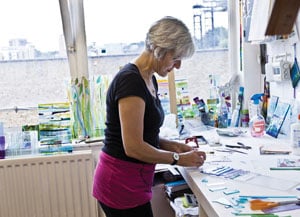Small is beautiful
The success of Cockpit Arts’ business growth loan scheme highlights the potential for tailored micro finance in the arts. Ellen O’Hara shares their experience

In a climate of reduced lending to small businesses across the board and funding cuts in the arts we need pioneering approaches to funding and finance for individual artists, designer-makers and other creative producers. While micro finance is most commonly applied as a means of alleviating poverty in the developing world, the model can be just as effective within the arts.
Cockpit Arts is an award winning social enterprise and the UK’s only creative-business incubator for designer-makers. We support 165 artists at our two London incubators – providing them with affordable studio space and a package of business and promotional support. The artists we work with are creative and ambitious but as sole traders the majority would be turned down were they to apply for a commercial loan on grounds of their credit record, lack of security, low profitability or seasonal income.
To address this, in 2006, we launched our own pilot business growth loan scheme supported by Esmée Fairbairn Foundation and explored a tailored model of micro finance for our artists. Loans of up to £10,000 were made available at a fixed rate of interest of 6% over 12 to 36 months. Twenty-one loans were made to 15 businesses, totalling £94,000, and the scheme had a zero bad debt record. Loan recipients have reported an average increase in turnover of 28%, and an average increase in profits of 75%. Furthermore, the increased profitability of the businesses has led to the creation of three PAYE jobs, 20 freelance opportunities and 17 internships over the last three years. A Social Return on Investment (SROI) evaluation has shown that the loan scheme created a considerable social value of between £2.01 and £3.36 for every pound of investment.
So how did we make it work? Not unlike development models pioneered by the likes of the Grameen Bank of Bangladesh, the Cockpit model is underpinned by principles of mutual trust, accountability, participation and creativity. Our incubation approach means that we develop close working relationships with our artists and this has been critical. Applicants are provided with intensive business support through every step of the process. This includes an initial business ‘health check’ and one-to-one coaching to build a robust business plan. We work with each artist to identify how and where they create value. From this evolves a business model which aims for an artist to generate enough profit to sustain the business and a full-time income for the artist, all the while allowing time, space and focus for creative development.
In some cases, they might reach this goal by achieving economies of scale, using the loan to improve production capacity and efficiency and simultaneously grow sales via e-commerce websites, trade shows and other sales activities. Or they might focus on small-scale high value sales, using the loan for creative development and high profile exhibitions to support entry to new high value markets.
Their business plan, which forms the basis of their application, is assessed by an independent, voluntary loans panel comprised of experts in creative business models, finance and manufacturing, and once a loan has been granted, Cockpit offers further intensive one-to-one coaching to help the recipients successfully implement their plans.
There have of course been challenges: in the early stages of the pilot we found that levels of financial literacy even among more established business owners were lower than expected. Business and financial planning templates were developed to support this and have worked well. In some cases the managerial responsibilities, such as people management, added unexpected pressures. This highlighted the importance of ongoing coaching to help guide business owners once the loan was awarded. The specialists within our loans panel also ensured that we avoided the pitfall of ‘under-funding’ applicants and helped us to apply the necessary conditions to release larger loans in stages to support manageable growth.
We took a SROI approach to understand the wider impacts of the pilot and to demonstrate how and why the scheme was a success. We found that a number of factors led to the overall improvements in business performance, and in particular a reported increase in business, finance and marketing skills. In addition, a number of social outcomes were identified, such as increased motivation and confidence to develop the business and increased job satisfaction. This, in turn, has helped to encourage a shift in culture at Cockpit Arts by creating peer competition, encouraging entrepreneurialism and objectivity, and positive role models for growth.
Ultimately we have recognised that our success was due to the affordable loan and business development support in equal measure, together with recognition that we are investing in the creative aspirations of the individual as well as the commercial potential of the business. The success of the pilot has enabled us to secure Ingenious as a new fund partner and The Cockpit Arts & Ingenious Loan Fund will allow us to continue the scheme for the next five years. As one of the leading investors in the UK’s creative industries, Ingenious recognised the value of the model we have created and we hope our experience inspires others in the sector to take the ‘small is beautiful’ approach with micro finance.
Join the Discussion
You must be logged in to post a comment.